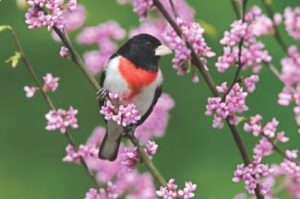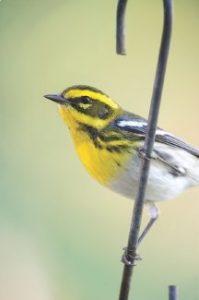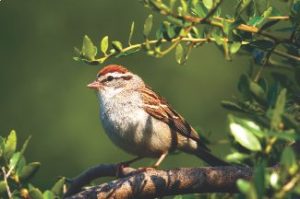Flying Colors is a sponsored column on the hobby of backyard bird feeding written by Michael Zuiker, owner of the Wild Birds Unlimited store at the Lee Harrison Shopping Center. Visit the store at 2437 N. Harrison Street or call 703-241-3988.
The maestro is ready. Resplendent in his red garment, he mounts the stage. The arena is respectfully still and quiet. The maestro sings his 8 note song to get the attention of the musicians.
Slowly, the musicians awaken and test out their vocal instruments. There are long, slow base notes. There are high pitched notes. There are repetitive notes. There are melodic notes.
 The musicians begin to interact and the notes and songs begin to intertwine to become a symphony of grand proportions. When you think another layer could not be offered, the percussion comes in and anchors the performance.
The musicians begin to interact and the notes and songs begin to intertwine to become a symphony of grand proportions. When you think another layer could not be offered, the percussion comes in and anchors the performance.
You have been to this performance. It is FREE!
You know the orchestra. It is right in your neighborhood. The performances are every day. Right at the break of dawn.
The magic of Spring (when and if the darn wind would ever stop) is the magnificent orchestra of the wild bird’s dawn symphony. Any small patch of woods, shrubs and landscaping will give you a performance of 15-20 different songbirds each calling out their signatures notes.
 The cardinal is the maestro, always seemingly the first to awaken the day. Its two to three second call — birdie, birdie, birdie or cheer, cheer, cheer is very easily distinguishable.
The cardinal is the maestro, always seemingly the first to awaken the day. Its two to three second call — birdie, birdie, birdie or cheer, cheer, cheer is very easily distinguishable.
The American Robin cheer-up, cherrio is also fast and repetitive. The Carolina Wren tea-kettle, tea-kettle, tea-kettle, tea has a fast and distinctive rhythm. Listen for the Carolina Chickadee asking for a cheeseburger. But don’t give him one! They prefer seeds, nuts and bugs.
Most yards can easily contain an orchestra of 20-30 different bird species, all with the unique calls. Add to that the percussion of Five woodpecker species banging on trees, telephone poles and metal exhaust vents on your house, and your rock and roll band is grooving.
What makes this even more exciting is that every Spring, guest artists migrate up from the south to join the band. These are Neo-Tropical birds migrating north from their Winter home in the tropics. Many Warbler species, Thrushes, Vireos and other singers can visit your yard.
 Being mostly insect eaters, the best way to see them is to offer water. Dripping or misting water is always the best option to attract birds to a bird bath.
Being mostly insect eaters, the best way to see them is to offer water. Dripping or misting water is always the best option to attract birds to a bird bath.
Their visit may be short; but their songs and distinct colors are breathtaking. Offering bark butter bits, fruit or dishes of mealworms is another sure way to get these migrating beauties in your yard singing a happy tune.
Customers have been coming in praising the songs of Grosbeaks, Cedar Waxwings and Chipping Sparrows. Stop in and fill up on these specialty foods and tell us about the amazing birds you are seeing this Spring.
Northern Virginia-check out these great birding spots for Spring.


